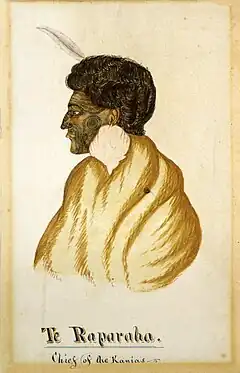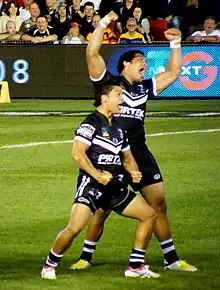Ka Mate
"Ka Mate" ([ˈkaˌmatɛ]) is a Māori haka composed by Te Rauparaha, war leader of the Ngāti Toa tribe of the North Island of New Zealand.

Composition
Te Rauparaha composed "Ka Mate" circa 1820 as a celebration of life over death after his lucky escape from pursuing Ngāti Maniapoto and Waikato enemies.[1][2] He had hidden from them in a pātaka, a food-storage pit while a woman (wāhine) by the name of Te Wharerangi straddled the pit to hide and protect him. Upon emerging from the pit and into the sun he was grateful to Wharerangi and his wife, composing the Ka Mate haka as a result.
The haka as composed by Te Rauparaha begins with a chant:[1][2]
Kikiki! Kakaka! |
Let your valor rise! Let your valor rage! |
Then follows the main body of the haka:
Ka mate, ka mate! ka ora! ka ora! |
It is death, it is death, it is life, it is life |
.jpg.webp)
"Ka Mate" was conceived as a brief energizing haka of the ngeri type, where, in the absence of set movements, the performers are free to extemporize their chanting and movement as they feel fit, without any need for synchronization.[3]
Use in rugby
| External video | |
|---|---|

"Ka Mate" is the most widely known haka in New Zealand and internationally because a choreographed and synchronized version[3] of the chant has traditionally been performed by the All Blacks, New Zealand's international rugby union team, as well as the Kiwis, New Zealand's international rugby league team, immediately prior to test (international) matches until 2013, when a specific haka, "Te Iwi Kiwi", was used instead. Since 2005 the All Blacks have occasionally performed another haka, "Kapa o Pango". Since the introduction of "Kapa o Pango" the longest sequence of "Ka Mate" performances by the All Blacks is nine, which has occurred twice between 22 August 2009 and 12 June 2010 and also between 13 August 2022 and 19 November 2022.[4] Before the end of the 2003 Rugby World Cup, the performance of the Ka Mate by the All Blacks usually ended with a mid-air leap.[5]
Prior to 1985 the All Blacks haka was not performed with the usual performance we are now used to. It took two Māori during this time Buck Shelford and Hika Reid to revolutionise the way it was delivered, culminating in a style close to the original haka. The non-Māori players from this point on learnt how to perform.[6]
In an interview with ESPN shortly before the 2019 Rugby World Cup, All Blacks scrum-half TJ Perenara, the team's designated haka leader at the time and a Māori who was raised in the region where Te Rauparaha lived, explained the process of selecting which haka will be performed before a given match:
There's Ka Mate and there's Kapa O Pango. When we're in Wellington we perform Ka Mate, we're paying respects to Te Rauparaha and the lands that he walked on. And then outside of that Reado [captain Kieran Read] and myself will usually talk [on match eve] or earlier in the week about what we'll do; what haka we'll do for that week. And it's usually just a vibe thing; how we feel; how we feel like our footy's going and who we're playing against. There's no massive reason for doing either one except for when we're in Wellington we always do Ka Mate.[7]
List of players that have led Ka Mate
Incomplete list of All Blacks players that have led the Ka Mate version of the haka:
- Piri Weepu (26)
- TJ Perenara (26)
- Keven Mealamu (23)
- Aaron Smith (21)
- Richie McCaw (11)
- Liam Messam (9)
- Rico Gear (6+)
- Carl Hayman (5)
- Hosea Gear (4)
- Dane Coles (4)
- Aaron Mauger (2)
- Kieran Read (1)
- Mils Muliaina (1)
- Tawera Kerr-Barlow (1)
- Nehe Milner-Skudder (1)
- Sam Cane (1)
- Codie Taylor (1)
- Tana Umaga
- George Nēpia
- Buck Shelford
- Taine Randell
- John Timu[8]
- Carlos Spencer[9]
- Zinzan Brooke[10]
- Norm Hewitt (1995 Rugby World Cup, vs Japan)
- Hika Reid
- Frank Shelford[11]
- Jamie Joseph (1995 Rugby World Cup, vs Wales and Ireland)
- Sid Going[12]
- Steve McDowall
- Stu Wilson (1979, vs England)
- Kees Meeuws (2001, vs Argentina)
- Greg Feek (2001, vs Ireland)
Numbers in brackets indicate how many times each player has led the "Ka Mate" haka. (correct as of 8 July 2023)
Teams who have faced Ka Mate
In total all 22 international rugby union sides that have played the All Blacks have faced "Ka Mate" before a test match. There are ten teams that have faced "Ka Mate", "Kapa o Pango", another haka or no prematch haka:
There are 12 international rugby union sides that have always faced "Ka Mate" before a match against the All Blacks:
All of the above 60 games were won by the All Blacks except for one against the World XV on 18 April 1992.[14] Numbers in brackets indicate how many times each team has faced the "Ka Mate" haka.
Ownership
Between 1998 and 2006, Ngāti Toa attempted to trademark "Ka Mate" to prevent its use by commercial organisations without their permission.[15][16] In 2006, the Intellectual Property Office of New Zealand declined their claim on the grounds that "Ka Mate" had achieved wide recognition in New Zealand and abroad as representing New Zealand as a whole and not a particular trader. In March 2011, New Zealand Rugby Union came to an amicable agreement with the iwi not to bring the mana of the haka into disrepute.[17]
In 2009, as a part of a wider settlement of grievances, the New Zealand government agreed to:
- "...record the authorship and significance of the haka Ka Mate to Ngāti Toa and ... work with Ngāti Toa to address their concerns with the haka... [but] does not expect that redress will result in royalties for the use of Ka Mate or provide Ngāti Toa with a veto on the performance of Ka Mate...".[18][19]
However, a survey of nineteenth-century New Zealand newspapers found Ka Mate was used by tribes from other parts of New Zealand, and was generally described by them as being an ancient peacekeeping song, from eras long before its appropriation by the Ngāti Toa chief Te Rauparaha. When Ngāti Toa authorities were asked for evidence that Ka Mate was of Ngāti Toa authorship, they were unable to provide any.[20]
In popular culture
In 2021, Glenn Osbourne turned the body of the haka into a ballad in C major.[21]
See also
References
- Pōmare, Mīria (12 February 2014). "Ngāti Toarangatira – Chant composed by Te Rauparaha". Te Ara – the Encyclopedia of New Zealand. Ministry for Culture & Heritage. Retrieved 31 August 2015.
- "Haka Ka Mate Attribution Act 2014 Guidelines" (PDF). Ministry of Business, Innovation & Employment. Archived from the original (PDF) on 23 January 2016. Retrieved 31 August 2015.
- Jackson, SJ; Hokowhitu, B (2002). "Sport, Tribes, and Technology: The New Zealand All Blacks Haka and the Politics of Identity". Journal of Sport and Social Issues. 26 (2): 125–139. doi:10.1177/0193723502262002. ISSN 0193-7235. S2CID 144368028.
- "Rugby Facts: The Ultimate Guide to Becoming a True Fan". 19 March 2014. Retrieved 4 April 2023.
- "Haka then and now: it used to be more funny than frightening". The Week UK. Retrieved 3 August 2023.
- "Buck Shelford Leads... The All Blacks Haka Revival". Rotorua Travel Secrets. Retrieved 10 July 2023.
- Bruce, Sam (15 September 2019). "Understanding the All Blacks' supreme success". ESPN.com. Retrieved 11 December 2019.
- Knowler, Richard. "Ex-All Black John Timu: 'Rugby union has given me everything'". Stuff. Retrieved 23 July 2023.
- Malley, Frank. "Spencer to lead Haka". ESPN. Retrieved 10 July 2023.
- "Ka Mate! Zinzan Brooke's guide to the Haka". the42. Retrieved 22 July 2023.
- France, Centre (23 October 2011). "Aulnat : Franck Shelford, un All Black est prêt pour le sacre de la Nouvelle-Zélande". www.lamontagne.fr. Retrieved 22 August 2023.
- World, Rugby (9 August 2023). "Who leads the haka for the All Blacks?". Rugby World. Retrieved 22 August 2023.
- JONES, MATT. "Rugby World Cup Results 2015: New Zealand vs. Georgia Score, Updated Fixtures". Bleacher Report. Retrieved 17 August 2023.
- "LOOKING BACK ON THE WORLD XV CENTENARY SERIES". allblacks.com. Retrieved 17 August 2023.
- "All Blacks fight to keep haka". news.bbc.co.uk. 16 July 2000. Retrieved 3 May 2008.
- "Iwi threatens to place trademark on All Black haka". New Zealand Herald. 22 May 2005. Retrieved 3 May 2008.
- "Iwi claim to All Black haka turned down". New Zealand Herald. 2 July 2007. Retrieved 3 May 2008.
- Ngāti Toa Rangatira Letter of Agreement Archived 21 May 2010 at the Wayback Machine
- "New Zealand Maori win haka fight". BBC News. 11 February 2009.
- "Archer J.H. (2009) Ka Mate; its origins, development and significance" (PDF).
- "Match Fit Season 2 Ep 3 | DOCUMENTARY/FACTUAL | ThreeNow". www.threenow.co.nz. Retrieved 29 June 2022.
External links
- The story behind "Ka Mate" – includes a recording
- Another and different translation of haka – tells the meaning behind the translation
- Ancient versions of Ka Mate – A comparative study of "Ka Mate" from ten different sources.